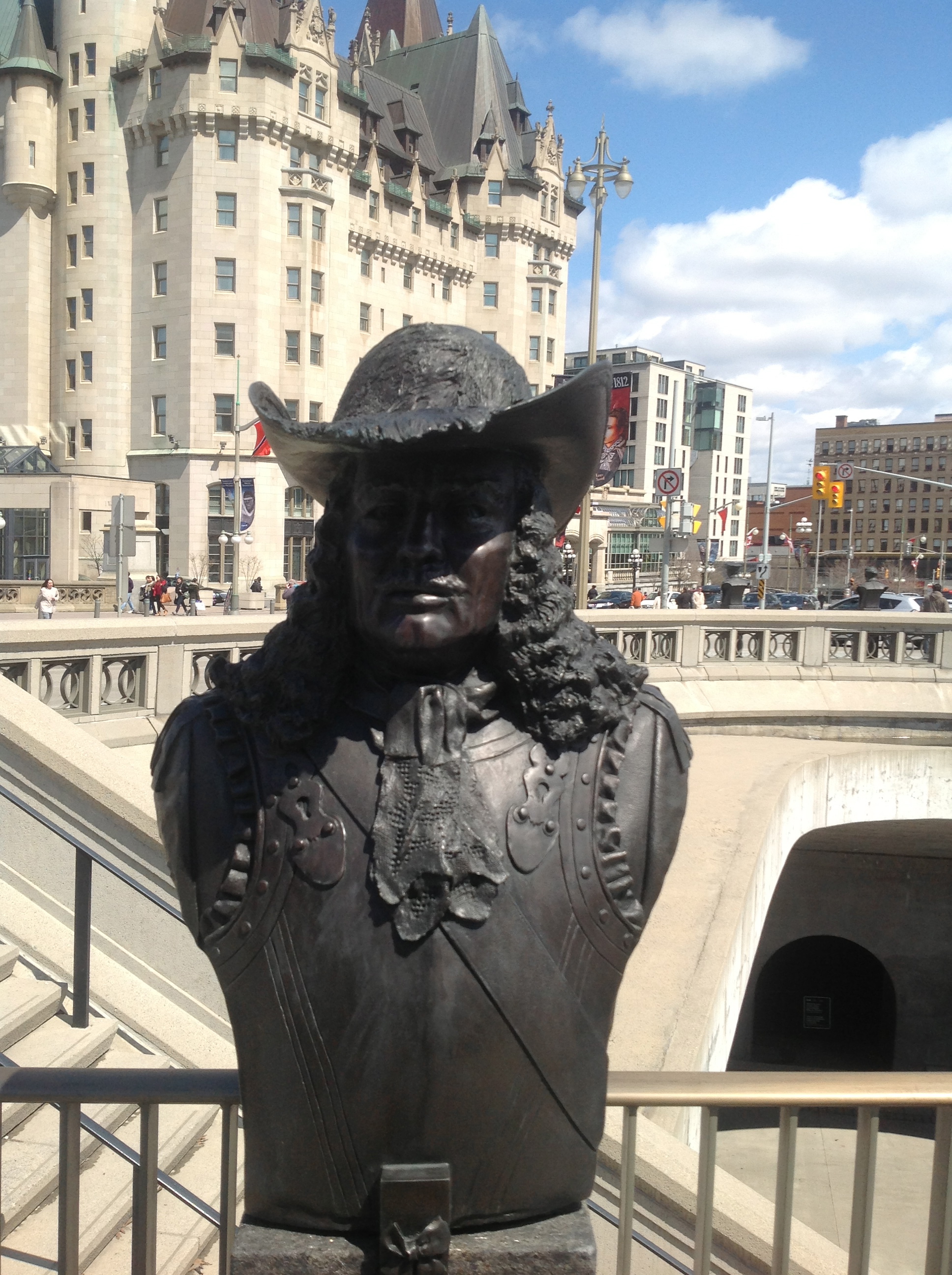
John Butler, Lieutenant-Colonel and leader of Butler's Rangers by Marlene Hilton Moore and John McEwen. 2006. Bronze with granite base. Ottawa, Ontario.
This memorial bust is but one of fourteen celebrating the accomplishments of Canadian military heroes from the seventeenth through the twentieth centuries in a group entitled "The Valiants Memorial" ("Le Monument aux Valeureux").
In the tranquil town of Niagara-on-the-Lake, where the Niagara River enters the Great Lake, Colonel John Butler established his headquarters during the American Revolution, and afterwards made the fertile, temperate peninsula his home. Parks Canada has provided the following commentary about John Butler's achievements a memorial plaque:
Born in New London, Connecticut, Butler settled in the Mohawk Valley, New York, in 1742. Commissioned in the British Indian Department in 1755, he served in the Seven Years' War. At the outbreak of the American Revolution, he was compelled to leave his estates and was ordered to Fort Niagara. In 1777 he organized the Loyalist corps known as Butler's Rangers. By the end of war, this unit with British regulars and Indian allies, had effectively contributed to the establishment of British control south of the Great Lakes. The Rangers were disbanded in 1784, and led by their former commander, many settled in the Niagara Peninsula. Butler remained active in Indian affairs until his death at Newark (Niagara-on-the-Lake).
In the autumn of 1778, as a result of the overcrowding of nearby Fort Niagara (captured by British and colonial forces in July 1759) with Loyalist settlers, Colonel Butler built barracks to house his Rangers and their families in what was later called "Fort George" (1796) to distinguish it from Fort Niagara on the eastern (American) side of the Niagara River. Disbanded in June 1784, his men were among the first Loyalists to settle in the Niagara peninsula. He became one of the leading members of the Anglican Church of St. Marks, along with General Sir Isaac Brock. On 27 May 1813, after a hotly contested fight, American forces seized Fort George, but that December British forces retook it, only to let it decay by the end of the War of 1812.
United Empire Loyalist Colonel John Butler, Niagara-on-the-Lake, Ontario
St. Mark's Anglican Church, Niagara-on-the-Lake, built in 1804, suffered the same fate as many other buildings in the British settlement in 1813, but was rebuilt and reconsecrated in 1822. A year after the 1842 visit of Charles and Catherine Dickens, transepts, chancel, and Gothic Revival pulpits were added. In the days when the city was the capital of Upper Canada, the church's leading parishioners included such heroes of the War of 1812 as Lieutenant Governor John Simcoe and Major-General Sir Isaac Brock, as well as Lieutenant-Colonel (retired) John Butler, whose memorial plaque in the nave reads as follows:
Fear God. Honour the King. In memory of Colonel John Butler, His Majesty's Commissioner for Indian Affairs. Born in New London, Province of Connecticut, 1728. His life was spent honorably in the service of the Crown. In the war with France for the conquest of Canada he was distinguished at the Battle of Lake George 8, Sept. 1775, and at the siege of Fort Niagara and its capitulation 25 July, 1759. In the war of 1776 he took up arms in defence of the unity of the Empire, and raised and commanded the loyal American Regiment of Butler's Rangers. A sincere Christian as well as a brave soldier, he was one of the founders and the first patron of this parish. He died at Niagara May 1796, and is interred in the family burial ground near this town. Erected 1880.
References
Allen, Robert S. "Niagara Historic Frontier." The Canadian Encyclopedia, ed. Mel Hurtig. Edmonton: Hurtig Publishing, 1988. Vol. 3, 1497.
"Colonel John Butler." Niagara-on-the-Lake. Parks Canada. Accessed 10 July 2013. www.ontarioplaques.com/Plaques_MNO/Plaque_Niagara01.html.
Field, John L. "Niagara-on-the-Lake." The Canadian Encyclopedia, ed. Mel Hurtig. Edmonton: Hurtig Publishing, 1988. Vol. 3, 1497.
Lapointe, E. B. "The Valiants Memorial to be Unveiled in Ottawa." 1 January 2006. Accessed 15 July 2013. http://www.genealogycanada.com/Valiants_Memorial.htm.
"Plaque Number One." Butler's Burial Grounds, Niagara-on-the Lake. Historical Plaques of the Niagara Region. Accessed 15 July 2013. http://www.waynecook.com/aniagara.html.
"The Valiants Memorial." Capital Public Art and Monuments. Ottawa. Accessed 10 July 2013. http://www.canadascapital.gc.ca/places-to-visit/public-art-monuments/valiants-memorial.
Ward, John. "Canadian Statue Commemorates Man Reviled in American History." CN News at Canoe.ca. 6 November 2006. Accessed 10 July 2013. http://cnews.ca .
Created 26 July 2013